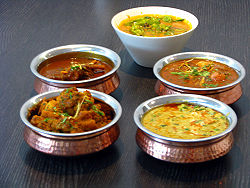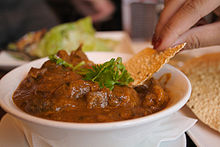 |
|
|
|
|
| Cuisines | Herbal | Spice | Curry | Yeast | Recipe | ||||||
|
Curry Curry (plural, Curries) is a generic term primarily employed in Western culture to denote a wide variety of dishes originating in Indian, Pakistani, Bangladeshi, Sri Lankan, Thai or other Southern and Southeastern Asian cuisines, as well as New World cuisines influenced by them such as Trinidadian or Fijian. Their common feature is the incorporation of more or less complex combinations of spices and/or herbs, usually (but not invariably) including fresh or dried hot chillies. In the original traditional cuisines, the precise selection of spices for each dish is a matter of national or regional cultural tradition, religious practice, and, to some extent, family preference. Such dishes are called by specific names that refer to their ingredients, spicing, and cooking methods. Traditionally, spices are used both whole and ground; cooked or raw; and they may be added at different times during the cooking process to produce different results. So-called "curry powder," denoting a commercially prepared mixture of spices, is largely a Western notion, dating to the 18th century. Such mixtures are commonly thought to have first been prepared by Indian merchants for sale to members of the British Colonial government and army returning to Britain. Dishes called "curry" may contain meat, poultry, fish, or shellfish, either alone or in combination with vegetables. They may instead be entirely vegetarian, especially among those for whom there are religious proscriptions against eating meat or seafood. Curries may be either "wet" or "dry." Wet curries contain significant amounts of sauce or gravy based on yoghurt, coconut milk, legume purée (dal), or stock. Dry curries are cooked with very little liquid which is allowed to evaporate, leaving the other ingredients coated with the spice mixture. Curries of the Indian SubcontinentFrom the culinary point of view, it is useful to consider the Indian subcontinent to be the entire historical region encompassed prior to Independence and the Partition of India in August, 1947; that is, the modern countries of India, Pakistan, Bangladesh, and Sri Lanka. It is usual to distinguish broadly between "northern" and "southern" styles of Indian cuisine, recognizing that within those categories are innumerable sub-styles and variations. The distinction is commonly made with reference to the staple starch: wheat in the form of unleavened breads in the north; rice in the south. Curries of Andhra PradeshAndhra cuisine is spicy and has a unique flavor, although there are regional variations in Andhra Pradesh cuisine. Telangana in the west of Andhra Pradesh has dishes hyderabadi biryani. In this region, the curry is flavored with spices like clove, cinnamon, nutmeg, anise, and bay leaf. The coastal Andhra Pradesh has more variety in their cuisine with a large variety of curries made from vegetables and a few curries made from meat. In this region, the curry is flavored with coriander powder, cumin seeds/powder, black pepper powder, red hot chili peppers/powder, asafoetida, ghee, fenugreek seeds, curry leaves and turmeric. It can be customized to use the local spices. The curries are mainly eaten with rice. Curries of GoaCurries known as vindaloo have become well known in Great Britain, America, and elsewhere, where the name is usually used simply to indicate a fiery dish of lamb or chicken frequently including potatoes. Such dishes are far from the Goan originals. The name "vindaloo" derives from the Portuguese vinha d'alhos or wine (vinho) and garlic (alho), the two definitive flavor ingredients. The dish was originally made with pork, not taboo to the Christian Portuguese. The inclusion of potatoes was a later Indian addition, thought to be the result of confusion with the Hindi word for potato, aloo (आलू). Curries of Karnataka The curries of Karnataka are typically vegetarian and with meat and fish around mostly coastal areas. They use a wide variety of vegetables and spices and coconut and jaggery are common tastes. There are dry and sauce based curries. Some typical sauce based dishes include Saaru, Gojju, Thovve, Huli, Majjige Huli; which is similar to the "kadi" made in the north, Sagu or Kootu, which is eaten mixed with hot rice. Curries of KeralaMalayali curries of Kerala typically contain shredded coconut paste or coconut milk, curry leaves, and various spices. Mustard seeds are used in almost every dish, along with onions, curry leaves, sliced red chilies fried in hot oil. Most of the non-vegetarian dishes are heavily spiced. Kerala is known for its traditional Sadya, a vegetarian meal served with boiled rice and a host of side-dishes, such as Parippu (Green gram), Papadum, some ghee, Sambar, Rasam, Aviyal, Kaalan, Kichadi, pachadi, Injipuli, Koottukari, pickles (mango, lime), Thoran, one to four types of Payasam, Boli, Olan, Pulissery, moru (buttermilk), Upperi, Banana chips, etc. The sadya is customarily served on a banana leaf. Curries of Tamil NaduBengali cuisine includes a plethora of curries. Seafood and fresh fish are a great favourite with Bengalis, and a large number of curries have been devised to accompany them. Mustard seeds and mustard oil are added to many recipes, as are poppy seeds. The Oriya people have similar eating habits and also prepare these types of curries. Bengali, Bangladeshi and Oriya curries Bengali cuisine includes a plethora of curries. Seafood and fresh fish are a great favourite with Bengalis, and a large number of curries have been devised to accompany them. Mustard seeds and mustard oil are added to many recipes, as are poppy seeds. The Oriya people have similar eating habits and also prepare these types of curries. Curries of MaharashtraThe curries of Maharashtra vary from mildly spicy to very spicy and include vegetarian, mutton, chicken and fish. Coastal Maharashtrian - Konkani - curries use coconut extensively along with spices. In western Maharashtra, curries are very spicy and groundnut powder is often added to it. Vidarbha's cuisine is usually spicier than that of the coastal and southern regions. The ingredients commonly used are besan, or chickpea flour, and groundnut powder. As a result of the long Islamic Moghul rule in the region, the cuisine of Aurangabad has been highly influenced by the North Indian method of cooking. Khandeshi food is very very spicy and most famous dish is Shev Bhaji, wange (Brinjal) che bharit and many more like Udidachi dal, Bharleli wangi (Brinjal), none other than Thecha (Mix of Garlic, Green chilies) bhakari and spicy mutton. Most of the people are farmers so their traditional food is very simple. Curries of Kashmir In the West, the best-known curry is Rogan josh, a wet curry of lamb with a brilliant red gravy whose color is derived from a combination of Kashmiri chillis (kashmiri mirchi) and an extract derived from the red flowers of the cockscomb plant (mawal). Goshtaba, (large lamb meatballs cooked in yoghurt gravy) is another curry dish from the Wazwan tradition occasionally found in Western restaurants. Curries of GujaratAlthough "wet curries" play a smaller role in Gujarat than elsewhere, there are a number of vegetarian examples with gravies based on buttermilk or coconut milk. The main ingredient may variously be brinjal (eggplant), potatoes, fresh corn kernels, okra, tomatoes, etc. In addition, there are several common kofta dishes which, of course, substitute vegetables for meat. Undhiyu, a Gujarati specialty, is a spicy "wet" mixed-vegetable "casserole" cooked in an earthenware pot, often eaten during the winter months. Curries of PunjabPunjabi curries are mainly based upon masalas. which is either a blend of dried (and usually dry roasted) spices, or a paste made from a combination of spices and a base of garlic, ginger, onions and tomatoes. A popular cooking fat is pure desi ghee, and some dishes are often enriched with liberal amounts of butter and cream. There are certain dishes that are exclusive to Punjab, such as Maha Di Dal and Saron Da Saag (Sarson Ka Saag). Pakistani cuisineA favourite Pakistani curry is Karahi, which is either mutton or chicken cooked in a cooking utensil called karahi, which is similar in shape to a wok. Lahori Karahi incorporates garlic, ginger, fresh chillies, tomatoes and select spices. Peshawari karahi is a simple dish made with just meat, salt, tomatoes and coriander. Sindhi cuisineSindhi cuisine refers to the cuisine of the Sindhi people. The daily food in most Sindhi households consists of wheat-based flat-bread (phulka) and rice accompanied by two dishes, one gravy and one dry. Curries of Sri LankaIn Sri Lankan cuisine, rice, which is usually consumed daily, can be found at any special occasion; whilst spicy curries are favourite dishes for dinner and lunch. 'Rice and curry' refers to a range of Sri Lankan dishes. Afghan and Pashtun cuisineThe cuisine of the Pashtun people in northwestern Pakistan is somewhat similar to the cuisine of neighbouring Afghanistan, which is largely based upon cereals like wheat, maize, barley and rice except with the addition of large South Asian influence. Accompanying these staples are dairy products (yoghurt, whey), various nuts, native vegetables, and fresh and dried fruits. Northeast Indian and Nepalese cuisinesThe curries of Northeast India are very different from those of other parts of India. This area's cuisine has been influenced by its neighbours, namely Burma and Tibet. Well known Indian spices are used less. Yak is a popular meat in this region of India. Daal bhaat (rice and lentil soup) is a staple dish of Nepal. Newa cuisine is a type of cuisine developed over centuries by the Newars of Nepal. Curries of ChinaChinese curries (咖哩, gā lǐ) typically consist of chicken, beef, fish, lamb, or other meats, green peppers, onions, large chunks of potatoes, and a variety of other ingredients and spices in a mildly spicy yellow curry sauce, and topped over steamed rice. White pepper, soy sauce, hot sauce, and/or hot chili oil may be applied to the sauce to enhance the flavor of the curry. The most common Chinese variety of curry sauce is usually sold in powder form. It seems to have descended from a Singaporean and Malaysian variety, countries which also introduced the Satay sauce to the Chinese. The ethnic Cantonese (dominant in Kuala Lumpur), this yellow, Chinese-Malaysian variety was naturally introduced to China by the Cantonese, and features typically in Hong Kong cuisine. (Interestingly, the Malay Satay seems to have been introduced to China with wider success by the ethnic Teochew, who make up the second largest group of Chinese of Singapore and are the dominant group in Thailand.) There are many different varieties of Chinese curry, depending on each restaurant. Unlike other Asian curries, which usually have a thicker consistency, Chinese curry is often watery. "Galimian," (from Malaysian "curry mee" or "curry noodles,") is also a popular Chinese curry dish. Curries of JapanJapanese curry (カレー karē?) is one of the most popular dishes in Japan, where people eat it an average of 84 times a year. It is usually eaten as karē raisu — curry, rice and often pickled vegetables, served on the same plate and eaten with a spoon, a common lunchtime canteen dish. It is less spicy and seasoned than Indian and Southeast Asian curries, being more of thick Japanese stew than a curry. Curry was introduced to Japan by the British in the Meiji era, after Japan ended its policy of national self-isolation (Sakoku), and curry in Japan was categorized as a Western dish. Its spread across the country is commonly attributed to its use in the Japanese Army and Navy which adopted it extensively as convenient field and naval canteen cooking, allowing even conscripts from the remotest countryside to experience the dish. The Japan Maritime Self-Defense Force traditionally have curry every Friday for lunch and many ships have their own unique recipes. The standard Japanese curry contains onions, carrots, potatoes, and sometimes celery, and a meat that is cooked in a large pot. Sometimes grated apples or honey are added for additional sweetness and other vegetables are sometimes used instead. For the meat, pork, beef and chicken are the most popular, in order of decreasing popularity. In northern and eastern Japan including Tokyo, pork is the most popular meat for curry. Beef is more common in western Japan, including Osaka, and in Okinawa chicken is favoured. Curry seasoning is commonly sold in the form of a condensed brick which dissolves in the mixture of meat and vegetables. Sometimes the curry-rice is topped with breaded pork cutlet (tonkatsu); this is called Katsu-karē ("cutlet curry"). Korokke (potato croquettes) are also a common topping. Apart from with rice, karē udon (thick noodles in curry flavoured soup) and karē-pan ("curry bread" — deep fried battered bread with curry in the middle) are also popular. Curry was introduced to Korea by the Japanese during their occupation in the early 20th century, and is hence nearly identical to the Japanese version. The common ingredients are rice, curry sauce, vegetables, kimchi, smoked pork, and wasabi. Southeast Asian cuisinesSoutheast Asia, including countries like Cambodia, Laos, Thailand and also some Southeast Asian minority groups, have their own versions of curry. Note that these countries have had many influences from Indian culture and cuisine, owing to South Asian travellers centuries before. Burmese cuisineBurmese cuisine is based on a very different understanding of curries. The principal ingredients of almost all Burmese curries are fresh onion (which provides the gravy and main body of the curry), Indian spices and red chilies. Usually, meat and fish are the main ingredients for popular curries. Burmese curries can be generalised into two types - the hot spicy dishes which exhibit north Indian or Pakistani influence, and the milder 'sweet' curries. Burmese curries almost overwhelmingly lack coconut milk, setting them apart from most southeast Asian curries. Regular ingredients include fresh onion, garlic and chili paste. Common spices include garam masala, dried chili powder, cumin powder, tumeric and ngapi, a fermented paste made from either fish or prawns. Burmese curries are quite oily, as the extra oil helps the food to last longer. A spaghetti equivalent called Nan gyi thohk exists, in which wheat or rice noodles are eaten with thick chicken curry. Indonesian cuisineIn Indonesia curry is called kari or kare. The most common type of kari consumed in Indonesia is kari ayam (chicken curry) and kari kambing (goat meat curry). Sumatran cuisine often reflect Indian influences, including curry. In Aceh and North Sumatra roti cane is often eaten with kari kambing. Other dishes such as gulai and opor are dishes based on curry. They are often highly localised and reflect the meat and vegetables available. They can therefore employ a variety of meats (chicken, beef, water buffalo and goat as in the flavoursome gulai kambing), seafood (prawn, crab, mussel, clam, squid, etc.), fish (tuna, mackerel, carp, pangasius, catfish), or vegetables (young jackfruit, common beans, cassava leaf) dishes in a spiced sauce. They use local ingredients such as chili peppers, kaffir lime leaves, lemongrass, galangal, Indonesian bay leaves (salam leaf), candlenuts, turmeric, turmeric leaves, asam gelugur and asam kandis (sour mangosteens similar to tamarind), shrimp paste (terasi), cumin, coriander seed and coconut milk. One popular curry-like dish is rendang from West Sumatran cuisine. Rendang often describes as curry dish, although it is nothing like curry since it contain less liquids and more rich and flavoursome. Authentic rendang uses water buffalo slow-cooked in thick coconut milk for a number of hours to tenderise, caramelize and give succulent flavour penetrate into the meat. In Aceh, curries use daun salam koja or daun kari (translated as "curry leaves"). Opor Ayam is another variation of curry, which tastes very similar to that of gulai. Opor usually whitish in color and does not use cinnamon nor turmeric, while gulai does. Opor is also known to be part of a family meal around Lebaran, while gulai can be commonly found in Padang restaurants. Malaysian cuisineBeing at the crossroads of ancient trade routes has left a mark on the Malaysian cuisine. While the curry may have initially found its way to Malaysian shores via the Indian population, it has since become a staple among the Malays and Chinese too. Malaysian curries differ from state to state, even within similar ethnic groupings, as they are influenced by the many factors, be it cultural, religious, agricultural or economical. Malaysian curries typically use curry powders rich in turmeric, coconut milk, shallots, ginger, belacan (shrimp paste), chili peppers, and garlic. Tamarind is also often used. Rendang is another form of curry consumed in Malaysia, Singapore, and Indonesia; although it is drier and contains mostly meat and more coconut milk than a conventional Malaysian curry. Rendang was mentioned in Malay literature Hikayat Amir Hamzah is popular among Indonesians, Singaporeans and Malaysians. All sorts of things are curried in Malaysia, including mutton, chicken, shrimp, cuttlefish, fish, aubergines, eggs, and vegetables. Philippine cuisineIn the Philippines, mostly a linear range of curry recipes could be seen. A typical curry dish would be usually of either pork or chicken as the meat while cooked at a similar manner as to other local dishes such as adobo, kaldereta, and mechado, patis (fish sauce), with potatoes, bay leaf, coconut milk, and sometimes lemongrass and carrots to complement. Another dish would be is the Kulma, or "Mindanao beef." Chicken cooked in coconut milk and curry powder is the usual curry dish that Filipinos are familiar with. Curries of ThailandIn Thai cuisine, curries are called kaeng, and the usually consist of meat, fish and/or vegetables in a sauce based on a paste made from of chilies, onions or shallots, garlic, and shrimp paste. Additional spices and herbs are defining for the type of curry. They use local ingredients such as chili peppers, kaffir lime leaves, lemon grass, galangal and, in central and southern Thai cuisine, also coconut milk. Northern and northeastern Thai curries generally do not contain coconut milk. Due to the use of fresh herbs, spices, and other fresh ingredients, Thai curries tend to be more aromatic than Indian curries. In the West, a few Thai curries are described by color; red curries use red chilies while green curries use green chilies. Yellow curry - called Kaeng kari (by various spellings) in Thai, of which a literal translation could be "curry soup" - is more similar to Indian curries, with the use of turmeric, cumin, and other dried spices. A few dishes also utilise an Indian style curry powder (Thai: pong kari). Curries of VietnamIn Vietnam, curry is called cà ri. Vietnamese curry features coconut milk, potato, sweet potato, taro roots, chicken garnished with cilantro and green onion and is more soup-like than Indian curry. Goat curry also exists but only at a few specialized restaurants. The curry is usually eaten with a baguette, rice vermicelli or steamed rice. At home, people usually only make chicken curry on each Death anniversary day of a family member. Vietnamese curry is considered a Southern food. Curry powderCurry powder is a spice mixture of widely varying composition developed by the British during the days of the Raj as a means of approximating the taste of Indian cuisine at home. Masala refers to spices, and this is the name given to the thick and pasty sauce based on a combination of spices with ghee (clarified butter), butter, palm oil or coconut milk. Most commercial curry powders available in Britain, the U.S. and Canada, rely heavily on ground turmeric, in turn producing a very yellow sauce. Lesser ingredients in these Western yellow curry powders are often coriander, cumin, fenugreek, mustard, chili, black pepper and salt. By contrast, curry powders and pastes produced and consumed in India are extremely diverse; some red, some yellow, some brown; some with five spices and some with as many as 20 or more. Besides the previously mentioned spices, other commonly found spices in different curry powders in India are allspice, white pepper, ground mustard, ground ginger, cinnamon, roasted cumin, cloves, nutmeg, mace, green cardamom seeds or black cardamom pods, bay leaves and coriander seeds. Health benefitsSome studies have shown that ingredients in curry may help to prevent certain diseases, including colon cancer and Alzheimer's disease. A number of studies have claimed that the reaction of pain receptors to the hotter ingredients in curries leads to the body's release of endorphins, curry is claimed to be one of the most powerful aphrodisiacs. With the complex sensory reaction to the variety of spices and flavours, a natural high is achieved that causes subsequent cravings, often followed by a desire to move on to hotter curries. Some refer to this as addiction, but other researchers contest the use of the word "addiction" in this instance. |











